Bryan David Griffith: En sus propias palabras
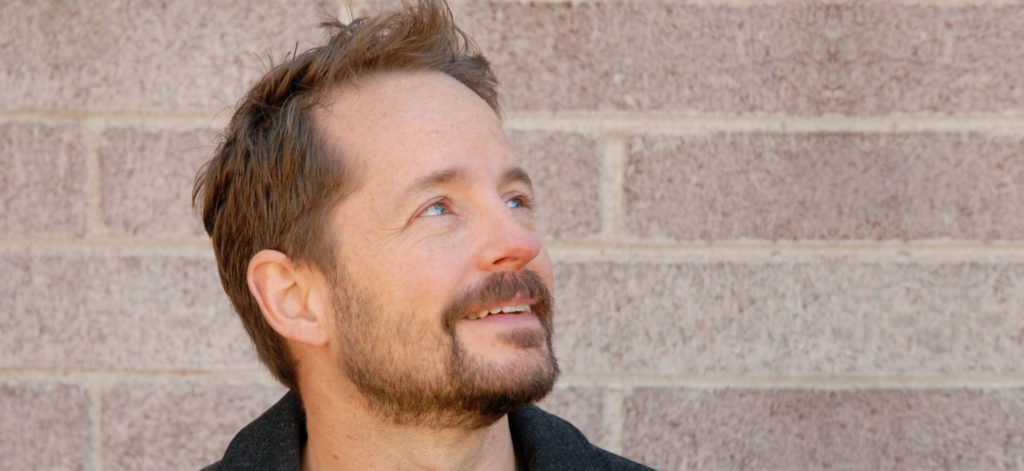
Jan, 03, 2023
ArtistasComunidadPhxArtista Destacado
Bryan David Griffith: En sus propias palabras
Bryan David Griffith wanders the woods to feed his creativity, often drawing inspiration from downed aspens, wildfire sites, and more. His journey to becoming the artist he is today started with a leap of faith, and ever since, he has challenged himself to find new ways of creating, experimenting with various tools, techniques, and media to explore the subtle nuances and enduring beauty of nature.
Over his career, Bryan’s work has been recognized by a number of awards, including the Flagstaff Arts Council’s 2016 Excellence in Visual Arts Award, and a 2016 Contemporary Forum Artist Grant from Phoenix Art Museum. He has exhibited his installations and photography at venues across world, including in Arizona, California, Oregon, Massachusetts, and China, and his work is in the permanent collections of the Museum of Fine Arts Houston, the Center for Creative Photography, and others.
We spoke with Bryan to learn about his process and continued evolution. Here he is, in his own words, on his practice, his artistic influences, and more.
“The thing about fire and natural materials is that they don’t bend to my will like human-made art materials do. They have a mind of their own.”
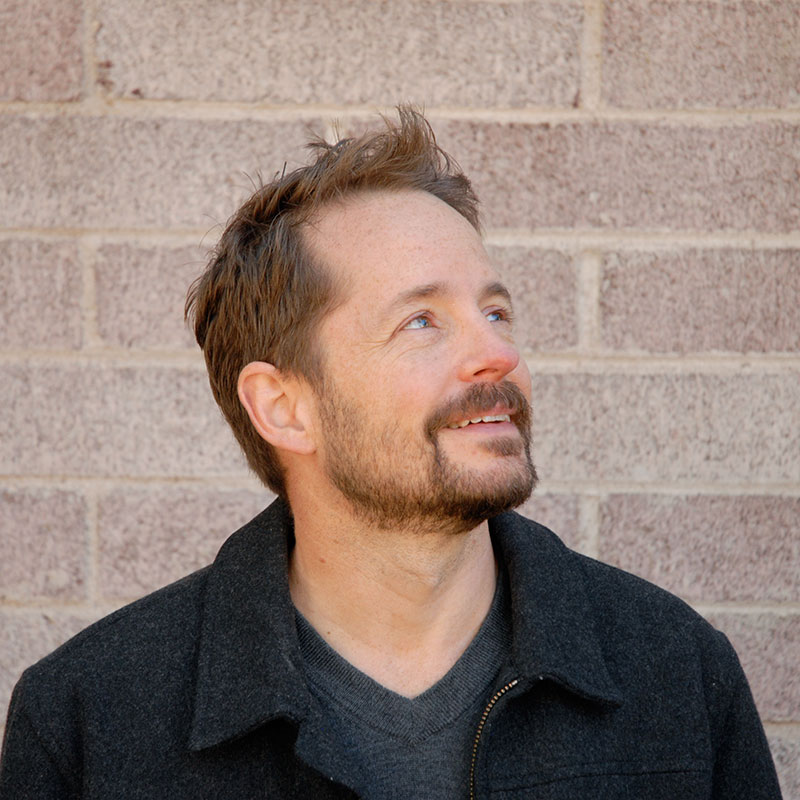
Bryan David Griffith, Portrait. Courtesy of the artist.
PhxArt: Tell us about who you are and what typically inspires your work.
Bryan David Griffith: I make my living as an artist, but I consider myself more of a thinker and a dreamer. I wander about at my own slow, meandering pace and generally do things the hard way. As a young boy, I spent a lot of time by myself in the woods. It’s still a place where I can go to recharge and get out of my head. Nature is full of colors and forms that are far more nuanced than anything I could come up with in the studio. I never know when inspiration may strike. The more time I spend outside, the more I stack the deck in favor of serendipity. A few years ago, I was out hiking after a windstorm and came across an aspen that had just blown down near the trail. I walked up to the top of the tree and stuck my head in. A field of leaves fluttered around me. In that moment, I envisioned a form to go with the concept of aspen regenerating, which I’d seen at a wildfire site I had visited a couple years prior. That’s how the installation Rebirth in my current exhibition Rethinking Fire was born.
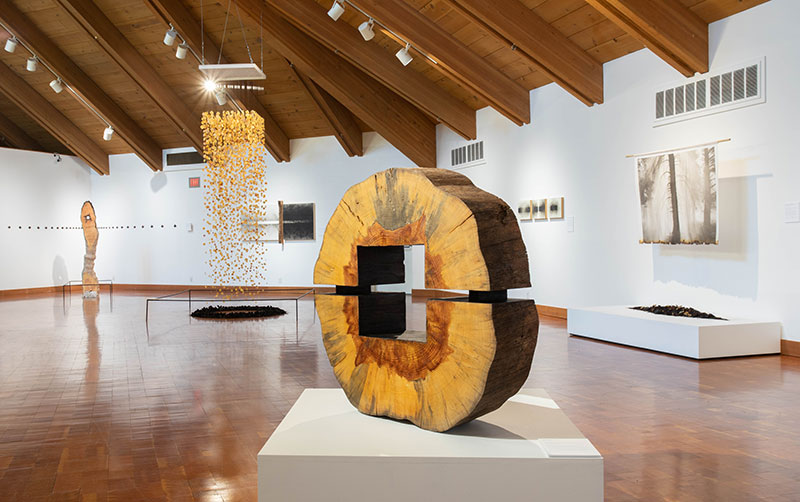
Installation view of Rethinking Fire, 2022 at World Forestry Center Discovery Museum. Courtesy of the artist, Photo: Jonathan Ley.
PhxArt: When did you know you wanted to be an artist? What was your first inspiration?
BG: I felt I was missing a creative outlet when I was an engineering student at the University of Michigan. One summer, I found a 1970s photography book by Henry Horenstein in the mothballed darkroom of the camp where I worked. There, I found my first inspiration. I taught myself photo printing in that darkroom with that very book. Senior year, I cobbled together a makeshift darkroom with garage-sale parts in the basement of an old house I was sharing with seven friends. I tried and failed to make prints like the Ansel Adams photos I had seen in the University of Michigan Museum of Art. Still, I was hooked on photography and kept at it.
I got hired by a management consulting firm out of college and moved to Chicago. It wasn’t engineering but, instead, a more lucrative job that everyone in business school wanted, so I was lucky to get it. But a few years in, I didn’t like the person I was becoming. I didn’t feel good about my project or about the environmental implications of what my client was doing. In a fit of idealism, I wrote a letter to all my coworkers and resigned. I bought an old van to live out of and hit the road to build a portfolio and make a living as a photographer. If I knew how difficult it was going to be, I might not have had the guts to do that. My naïveté helped me find the courage.
Sure enough, I lost about everything I had within the first year. Nevertheless, my work was getting better just from the sheer number of hours spent camping out and learning how light moves across the landscape. By the end of the following year, I sold enough work to get by and considered renting a place. My van happened to break down in Flagstaff. It was a gorgeous autumn, and the aspens had just started to change. I never left. I fell in love with the landscape and then my future wife, who grew up in Flagstaff.
PhxArt: Tell us about your process and how it’s evolved.
BG: My process has evolved dramatically in ways I didn’t expect. I started out with a big old bellows camera, making meditative photos of the solace I found in nature. I wanted to inspire people to visit and help preserve our wild landscapes. Then, I started making more experimental, alternative-process photos with scavenged homemade equipment. That series featured small figures finding their way, acting as metaphors for my own memories. In 2014, I received a grant to study wildfire with scientists and create photos for a yearlong group project called Fires of Change. Partway through the project, I realized my photography wasn’t the right way to tackle the concept I was after. So I took a hard left turn into experimental painting, sculpture, and installation with natural materials. When that group exhibition opened, my own friends didn’t know which work was mine because it was so different. From there I kept wandering off the map. I am now an artist-at-large, which is both liberating and terrifying!
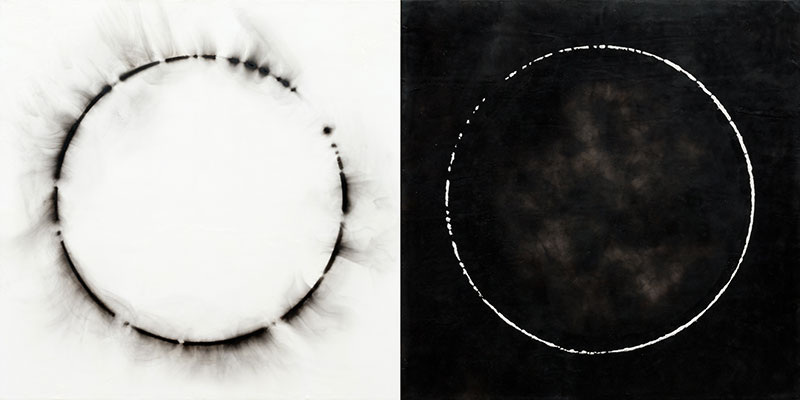
Bryan David Griffith, Traces I & II, 2020.Smoke from fire accumulated in encaustic beeswax on wood panel. 30 x 30 x 2.5 inches (per panel). Courtesy of the artist and Bentley Gallery.
PhxArt: Do you work in a particular medium, and if so, why?
BG: I no longer define myself by media. These days, anything goes! For the last couple of projects, I started out with the concept and then experimented until I came up with my own way of making it that married well with that concept. Those projects deal with environmental and climate issues around wildfire and water, so I used a lot of foraged natural materials, which roots the work in the landscape it’s about. The thing about fire and natural materials is that they don’t bend to my will like human-made art materials do. They have a mind of their own. The work is more of a conversation, a dance with a stranger who speaks a different tongue. When it works, there’s a primal energy beneath the surface of the piece. The wild and calm coexist. That juxtaposition between the organic and geometric speaks to the relationship between nature and humanity.
Working this way has led me into some unexpected grey areas between media that hopefully feel fresh and authentic. In my latest exhibitions, I even change media within the same body of work. That sounds like a mess, but with closely related forms, palettes, and concepts running through the show, it holds together and keeps the viewer on their toes.
PhxArt: Who are your greatest artistic influences?
BG: Like all artists, I stand on the shoulders of many who have come before me. In terms of impact, my biggest influences were my high school art teachers, Jill Waskowsky and Dee Fitzsimmons. They encouraged me by entering my paintings in competitions, while also pushing me after class to think more deeply about concept and design. Without them, I wouldn’t be where I am today. When Dee learned I was going to study engineering, she said, “Just remember, the art school is across the street. No matter what you do, you’ll always be an artist inside.” I tried hard to ignore that, but it turns out she was right.
I draw a lot of inspiration from conversations with other artists, including musicians, writers, dancers, and others at all levels. Creatives of all types survive by being resourceful, nimble, and brave. We are all digging for the same fire, tapping into the same joy, tragedy, and mystery of the human experience. When my enthusiasm wanes, the passion in a young artist’s work can fire me up again. Sometimes those conversations can lead to unexpected ideas. One day, I was talking with my wife about one of her natural dye experiments. I realized that she was manipulating the same chemical reaction that I had been using in alternative-process photography, just from the opposite side of the equation. Thinking about that in my wife’s perspective opened up a new variation of the process I hadn’t seen published anywhere. Not only new ideas but also new techniques can come from thinking outside a single medium silo.

Bryan David Griffith, Rebirth, 2021. Aspen leaves preserved in beeswax, burned conifer debris from fire site. 60 x 60 x 120 inches. Courtesy of the artist.
PhxArt: What’s something you’re currently working on or have recently exhibited?
BG: I currently have a solo exhibition at the World Forestry Center Discovery Museum in Portland called Rethinking Fire. The response has been very positive, and I’m happy to announce that the museum is going to extend it until summer 2023. It’s about wildfires and takes up half of the entire second floor of the museum with experimental paintings, sculptures, and four major installations. I created each piece by burning or salvaging materials from fire sites. Everything in the show was on fire at some point! I‘ve collaborated with scientists to make work in this series since 2014. This version of the show features quotes and issue text contributed by a number of scientists, including Paul Hessburg from the Forest Service Pacific Northwest Research Station, who helped edit and joined me for the opening lecture. Collaborating with passionate scientists like Paul inspires me to think in new directions. You can see a short video interview and walkthrough of the show here.
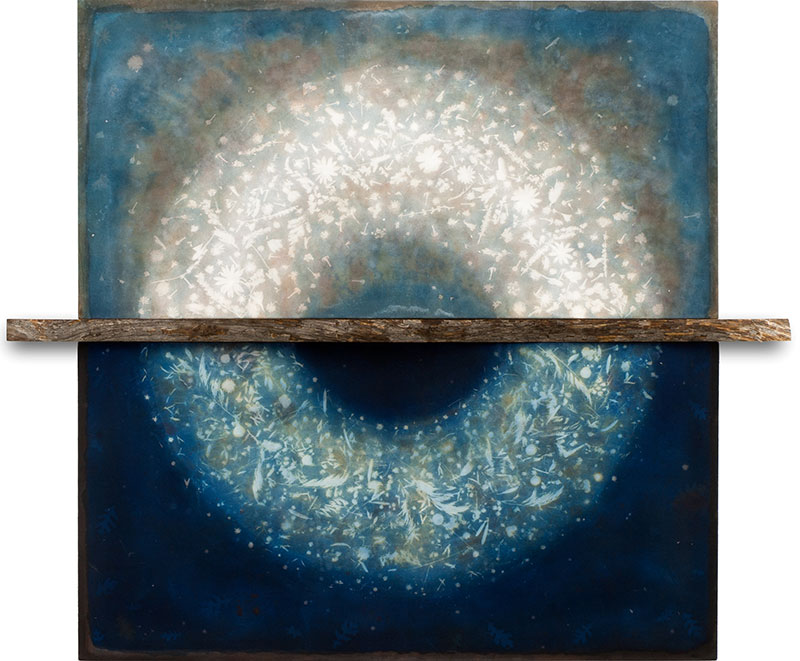
Bryan David Griffith, Monsoon Flowers, September Seeds, 2021. Cyanotype, foraged natural dyes and pigments, acrylic on canvas with wood. 58 x 50 x 4.5 inches. Courtesy of the artist.
PhxArt: What is some advice you’d give to aspiring artists just beginning to build their professional practice?
BG: Get out there and get your hands dirty. The only way to make good art is to make lots of bad art first. When you get to a place where you’re making good art, keep taking chances and allowing yourself to fail. It’s easy to stagnate once you find something that works and people are buying it. But art must evolve to keep its magic.
Also, realize that courage and persistence are more important than talent. Success in the arts depends on being in the right place at the right time. The odds of winning any given opportunity are slim. So focus on what you can control: make the best, most relevant work you can and try again and again in the face of rejection. Seek out criticism and learn from those rejections, but don’t judge yourself by them. Judge yourself by whether you’ve given your best shot. Celebrate each time you send in a submission instead of waiting for the results.
PhxArt: What can our community expect to see next from you? Anything on the horizon?
BG: I have a project about water and climate change called Watershed, which I’m in the process of expanding and looking to showcase at some point in the Valley or Tucson. I started a new band called The Carbonics and have been writing a lot of songs. It’s fun to have another creative outlet that doesn’t carry the same expectations as my art practice. This fall, I was out hiking and once again came across two huge downed aspen trees, this time cut down to protect power lines. I gathered thousands of their leaves for a future installation idea. My work is challenging to make. Most of it has to be made outside when the weather is favorable and materials are in season. I can’t just go into the studio and churn things out. But the greater challenge is finding ways to fund and venues to host my work, especially when we are talking about installations that take hundreds of hours to complete. The truth is, I have proposals out there, but I don’t know if any will come to pass. More than once, things have looked dire, but then a grant comes through or a collector buys a big painting and that enables a project to happen.
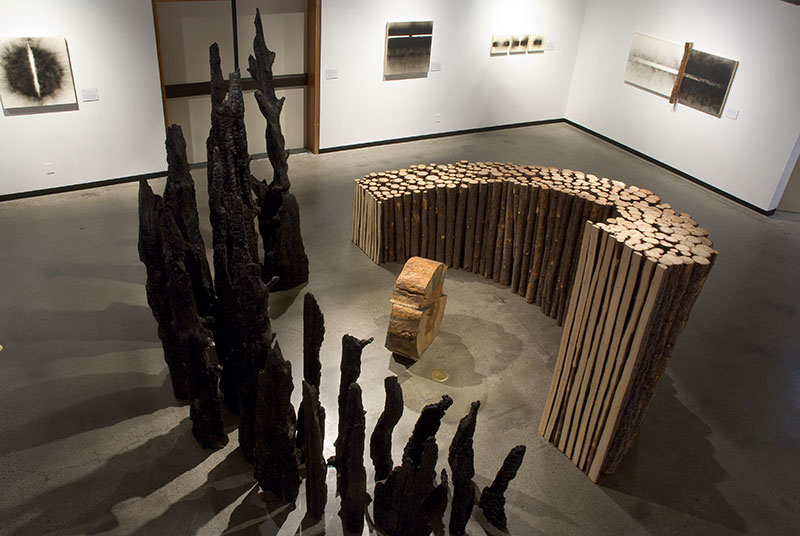
David Bryan Griffith, Broken Equilibrium & Reconstruction, 2015. Trees from thinning projects and wildfire sites. 162 x 158 x 96 inches. Courtesy of the artist.
SEE MORE
To see more artwork by Bryan David Griffith, visit bryandavidgriffith.com or follow him on Facebook and Instagram @bryandavidgriffith. To see more artwork in-person, visit Bentley Gallery in Phoenix. To hear more about his band, The Carbonics, visit their Instagram @TheCarbonics.
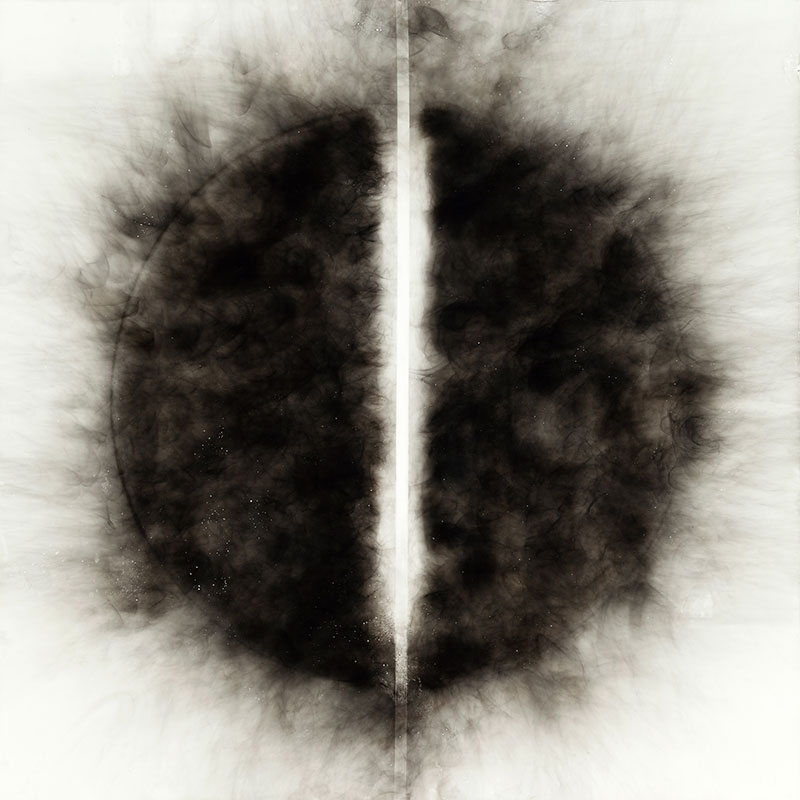
Bryan David Griffith, Fissure, 2016. Smoke from fire accumulated in encaustic beeswax on panel. 30 x 30 x 2.5 inches. Courtesy of the artist.
Categories
What can we help you find?
¿Necesitas más ayuda?
Llame a Servicios para visitantes al 602.257.1880 o envíe un correo electrónico